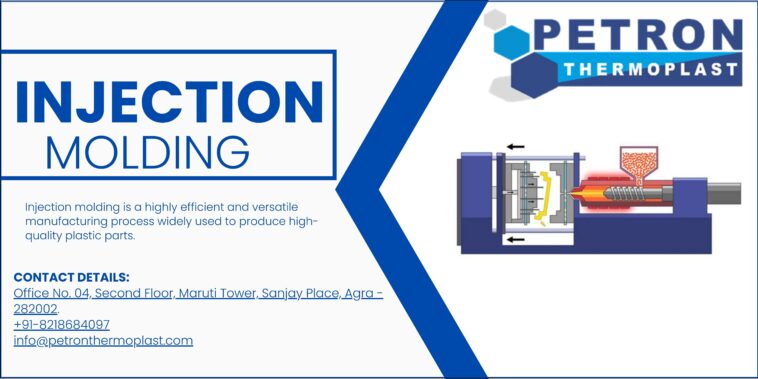Molding is a manufacturing process in which raw material is shaped into a desired form using a mold. The mold, typically made of metal, contains a hollow cavity that mirrors the final product’s shape. During the molding process, the material, which can be plastic, metal, or rubber, is heated until pliable, then injected or pressed into the mold cavity. Once the material cools and solidifies, it takes the shape of the mold, producing a finished component or product. This process is widely used in various industries to create parts with complex shapes and high precision.
Injection Molding is a specific type of molding process primarily used for producing plastic parts. It involves melting plastic pellets and injecting the molten material into a mold under high pressure. Once inside the mold, the plastic cools and solidifies, forming the final product. Injection molding is highly versatile and can produce a wide range of parts, from tiny components to large and complex items.
Key Features of Injection Molding:
- High Efficiency: Capable of producing large volumes of parts quickly and consistently.
- Precision and Consistency: Ensures uniformity and high precision in each produced part.
- Material Versatility: Can utilize various thermoplastic and thermosetting polymers.
- Complex Shapes: Allows for the creation of intricate and detailed parts.
- Reduced Waste: Excess material can often be recycled and reused in the process.
Types of Injection Molding
-
Thermoplastic Injection Molding: The most common type, this process uses thermoplastic polymers that become pliable when heated and solidify upon cooling. It is widely used in producing consumer goods, automotive parts, and medical devices.
-
Thermoset Injection Molding: Involves the use of thermosetting polymers that harden permanently after being heated. This process is ideal for parts requiring high heat resistance and structural integrity, such as electrical components and automotive parts.
-
Overmolding: A specialized process where additional materials are molded over an existing part. It is used to create multi-material parts or parts with soft-touch surfaces, such as handles and grips.
-
Insert Molding: Involves molding plastic around a pre-placed insert, usually metal. This process is used to manufacture parts with metal components embedded within plastic, such as threaded inserts and electrical connectors.
-
Gas-Assisted Injection Molding: Utilizes nitrogen gas to create hollow sections within parts, reducing weight and material usage. This method is often used for producing large, lightweight, and structurally sound parts.
-
Liquid Silicone Injection Molding: Specialized for silicone rubber, this process is used for parts requiring flexibility, heat resistance, and biocompatibility, such as medical devices and seals.
Industrial Applications
-
Automotive Industry: Injection molding is used to manufacture various components, including dashboards, bumpers, and interior trim parts. The process ensures high precision and durability, essential for automotive applications.
-
Consumer Goods: Many everyday items, such as plastic containers, toys, and household appliances, are produced using injection molding. The ability to produce large quantities of uniform parts makes it ideal for consumer goods manufacturing.
-
Medical Devices: Precision and biocompatibility are crucial in the medical field. Injection molding is used to produce surgical instruments, diagnostic devices, and disposable items like syringes and IV components.
-
Electronics: The electronics industry relies on injection molding to create casings, connectors, and other components that require tight tolerances and complex geometries.
-
Packaging: Injection molding is used to produce various packaging solutions, including caps, closures, and containers, ensuring consistency and efficiency in high-volume production.
-
Construction: Components like pipe fittings, insulation parts, and fasteners are manufactured using injection molding, offering durability and precision required in construction applications.
Manufacturing Material
Injection molding primarily utilizes thermoplastic and thermosetting polymers. The choice of material depends on the intended application, required properties, and cost considerations.
Common Thermoplastic Materials:
- Polyethylene (PE): Known for its flexibility, toughness, and resistance to moisture. Used in packaging, containers, and household goods.
- Polypropylene (PP): Offers high chemical resistance and mechanical strength. Used in automotive parts, textiles, and consumer products.
- Polyvinyl Chloride (PVC): Known for its durability and chemical resistance. Used in pipes, fittings, and construction materials.
- Acrylonitrile Butadiene Styrene (ABS): Offers high impact resistance and toughness. Used in automotive parts, consumer electronics, and toys.
- Polystyrene (PS): Known for its clarity and rigidity. Used in disposable cutlery, packaging, and insulation.
Other Essential Details
-
Tooling and Mold Design: The design and quality of the mold are crucial in injection molding. Precision in mold design ensures the accuracy and quality of the final parts. Molds are typically made from hardened steel or aluminum, with intricate details crafted to match the desired part specifications.
-
Cycle Time: The cycle time, or the time it takes to complete one injection molding cycle, is a critical factor in production efficiency. It includes the time for injection, cooling, and ejection of the part. Reducing cycle time without compromising quality is a key goal in optimizing the injection molding process.
-
Quality Control: Ensuring the consistency and quality of injection-molded parts is essential. Quality control measures include inspecting parts for defects, ensuring dimensional accuracy, and conducting material tests to verify properties.
-
Environmental Considerations: Injection molding generates plastic waste in the form of sprues, runners, and rejected parts. Implementing recycling programs and using biodegradable or recycled materials can help reduce the environmental impact.
In summary, injection molding is a highly efficient and versatile manufacturing process widely used to produce high-quality plastic parts. Understanding the different types of injection molding, the materials used, and the industrial applications can help select the right process and material for specific needs. Manufacturers can achieve consistent and reliable results in their injection molding operations by ensuring proper mold design, optimizing cycle times, and implementing quality control measures.
FAQs
Q1: What are the main advantages of injection molding?
A: Injection molding offers high efficiency, precision, and the ability to produce complex shapes. It is suitable for large-volume production and can utilize various materials, making it versatile and cost-effective.
Q2: Can injection molding be used for small-scale production?
A: While injection molding is ideal for large-scale production, it can also be used for small-scale production. However, the initial cost of mold creation can be high, making it more economical for larger production runs.
This post was created with our nice and easy submission form. Create your post!





